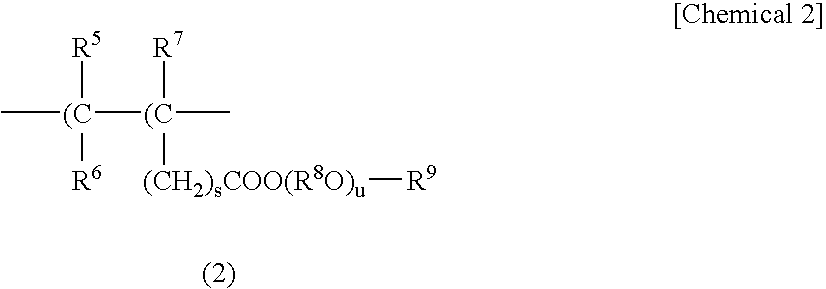Drying shrinkage-reducing agent
a shrinkage-reducing agent and drying technology, applied in the field of drying shrinkage-reducing agents, can solve the problems of enlarging cracks, preventing the attainment of sufficient reducing effects, and difficulty in adjusting the amount of using expanding agents, so as to enhance the durability of cured products, reduce the surface tension of water, and exalt the safety of civil engineering
- Summary
- Abstract
- Description
- Claims
- Application Information
AI Technical Summary
Benefits of technology
Problems solved by technology
Method used
Image
Examples
production example 1
[0093] In a glass reaction vessel equipped with a thermometer, a stirrer, a dropping funnel, a nitrogen conducting tube, and a reflux condenser, 198.91 parts of 2-propanol, 54.51 parts of 2-ethylhexyl methacrylate, 67.99 parts of methoxypolyethylene glycol monomethacrylate (average addition mol number of ethylene oxide of 23; namely in the above formula (2), R5=H, R6=H, R7=CH3, R8=C2H4, R9=CH3, s=0, and u=23), and 0.71 part of 3-mercaptopropionic acid as a chain transfer agent were placed and stirred while the interior of the reaction vessel was displaced with nitrogen and heated under an atmosphere of nitrogen to 65° C. Next, an initiator solution composed of 1.41 parts of 2,2′-azobis(2,4-dimethyl valeronitrile) and 28.6 parts of 2-propanol was added dropwise thereto over a period of five hours. Thereafter, the interior temperature of the reaction vessel was continuously maintained at 65° C. for one hour to complete the polymerization. The resultant reaction solution was distilled ...
production example 2
[0094] In a glass reaction vessel equipped with a thermometer, a stirrer, a dropping funnel, a nitrogen conducting tube, and a reflux condenser, 198.91 parts of 2-propanol, 46.92 parts of 2-ethylhexyl methacrylate, 75.58 parts of methoxypolyethylene glycol monomethacrylate (average addition mol number of ethylene oxide of 9; namely in the above formula (2), R5=H, R6=H, R7=CH3, R8=C2H4, R9=CH3, s=0, and u=9), and 0.62 part of 3-mercaptopropionic acid as a chain transfer agent were placed and stirred while the interior of the reaction vessel was displaced with nitrogen and heated under an atmosphere of nitrogen to 65° C. Next, an initiator solution composed of 1.41 parts of 2,2′-azobis(2,4-dimethyl valeronitrile) and 28.6 parts of 2-propanol was added dropwise thereto over a period of five hours. Thereafter, the interior temperature of the reaction vessel was continuously maintained at 65° C. for one hour to complete the polymerization. The resultant reaction solution was distilled to...
production example 3
[0095] In a glass reaction vessel equipped with a thermometer, a stirrer, a dropping funnel, a nitrogen conducting tube, and a reflux condenser, 198.91 parts of 2-propanol, 55.17 parts of 2-ethylhexyl methacrylate, 62.53 parts of methoxypolyethylene glycol monomethacrylate (average addition mol number of ethylene oxide of 23; namely in the above formula (2), R5=H, R6=H, R7=CH3, R8=C2H4, R9=CH3, s=0, and u=23), 4.80 parts of methacrylic acid, and 0.83 part of 3-mercaptopropionic acid as a chain transfer agent were placed and stirred while the interior of the reaction vessel was displaced with nitrogen and heated under an atmosphere of nitrogen to 65° C. Next, an initiator solution composed of 1.41 parts of 2,2′-azobis(2,4-dimethyl valeronitrile) and 28.6 parts of 2-propanol was added dropwise thereto over a period of five hours. Thereafter, the interior temperature of the reaction vessel was continuously maintained at 65° C. for one hour to complete the polymerization. The resultant ...
PUM
| Property | Measurement | Unit |
|---|---|---|
| surface tension | aaaaa | aaaaa |
| surface tension | aaaaa | aaaaa |
| surface tension | aaaaa | aaaaa |
Abstract
Description
Claims
Application Information
 Login to View More
Login to View More - R&D
- Intellectual Property
- Life Sciences
- Materials
- Tech Scout
- Unparalleled Data Quality
- Higher Quality Content
- 60% Fewer Hallucinations
Browse by: Latest US Patents, China's latest patents, Technical Efficacy Thesaurus, Application Domain, Technology Topic, Popular Technical Reports.
© 2025 PatSnap. All rights reserved.Legal|Privacy policy|Modern Slavery Act Transparency Statement|Sitemap|About US| Contact US: help@patsnap.com



